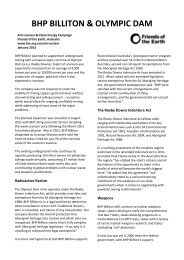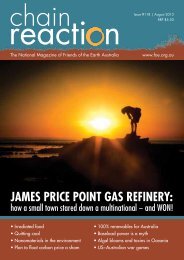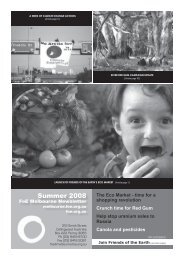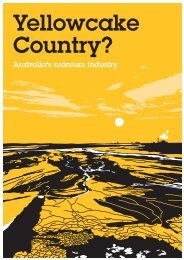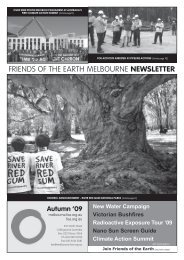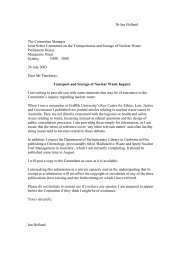Thirty Years of Creative Resistance - Friends of the Earth Australia
Thirty Years of Creative Resistance - Friends of the Earth Australia
Thirty Years of Creative Resistance - Friends of the Earth Australia
You also want an ePaper? Increase the reach of your titles
YUMPU automatically turns print PDFs into web optimized ePapers that Google loves.
The first <strong>Friends</strong> <strong>of</strong> <strong>the</strong> <strong>Earth</strong><br />
(FoE) group in <strong>Australia</strong> formed<br />
in Adelaide in 1972, one <strong>of</strong> a<br />
number <strong>of</strong> organisations that<br />
grew out <strong>of</strong> a group called Social<br />
Action. In early 1973, FoE was<br />
established in Melbourne. These<br />
early organisations, based in <strong>the</strong><br />
broad social movements that<br />
were forming across <strong>Australia</strong> and<br />
around <strong>the</strong> world, were products <strong>of</strong><br />
<strong>the</strong>ir times.<br />
The FoE group world wide was<br />
originally set up by David Brower and<br />
o<strong>the</strong>rs in <strong>the</strong> USA in 1969, after David<br />
resigned from <strong>the</strong> Sierra Club (a large<br />
and mainstream nature-conservation<br />
orientated group) frustrated that <strong>the</strong><br />
organisation would not tackle nuclear<br />
issues or work at <strong>the</strong> international level.<br />
Thus, from its beginning, FoE was<br />
international in its perspective and had a<br />
strong focus on social issues. The idea<br />
<strong>of</strong> an environmental network working on<br />
contemporary issues in new ways was<br />
clearly a timely one and groups quickly<br />
formed in a number <strong>of</strong> countries.<br />
FoE was established in <strong>the</strong> early stages<br />
<strong>of</strong> <strong>the</strong> social transformation happening<br />
across <strong>Australia</strong> that had been influenced<br />
by similar movements elsewhere in<br />
<strong>the</strong> 1970s. There was a growing public<br />
awareness <strong>of</strong> ecology, <strong>the</strong> land rights<br />
movement was becoming increasingly<br />
militant and <strong>the</strong> NSW Builders Labourers<br />
Federation (BLF) under <strong>the</strong> leadership <strong>of</strong><br />
Jack Mundey was pr<strong>of</strong>oundly changing<br />
<strong>the</strong> role <strong>of</strong> trade unions as it took a leading<br />
national position on a range <strong>of</strong> social and<br />
environmental concerns. The alternate<br />
lifestyle counter culture had held a number<br />
<strong>of</strong> enormous ga<strong>the</strong>rings and <strong>the</strong> women’s<br />
and gay liberation movements were<br />
prominent and dynamic.<br />
Against this social backdrop, FoE, based<br />
on <strong>the</strong> concept <strong>of</strong> radical grassroots<br />
environmental action, took <strong>of</strong>f like wildfire.<br />
FoE’s origins contrasted some <strong>of</strong> <strong>the</strong><br />
slightly older environmental organisations<br />
that were described in 1976 by FoE<br />
...................................................................................................................................................................................................<br />
activist, Neil Barrett as <strong>the</strong> “establishment,<br />
government-funded group(s) which<br />
sprang out <strong>of</strong> an older style, middle class<br />
movement”. For many, <strong>the</strong> new network<br />
structure <strong>of</strong> FoE was important because<br />
it <strong>of</strong>fered an alternative to <strong>the</strong> <strong>of</strong>ten<br />
hierarchical structures <strong>of</strong> many o<strong>the</strong>r<br />
national environment groups.<br />
FoE is a prominent example <strong>of</strong> ‘second<br />
wave’ environmentalism. From its<br />
inception, it was very much a part <strong>of</strong> <strong>the</strong><br />
broader social movements <strong>of</strong> <strong>the</strong> day,<br />
and political opinions and styles within<br />
<strong>the</strong> network were diverse. As Margaret<br />
Jones later commented in Chain Reaction<br />
magazine in 1982, “FoE appeared<br />
to me to be somewhat fragmented.<br />
Some campaigns were run on a liberalauthoritarian<br />
structure, while in o<strong>the</strong>rs<br />
attempts at collectivism were made. Some<br />
argued that FoE’s many varied campaigns<br />
required equally varied methods and that<br />
a uniform structure or commitment to an<br />
ideology would be repressive.” While <strong>the</strong>re<br />
was diversity <strong>of</strong> opinion and politics and<br />
some internal disagreements, FoE was<br />
firmly based in a broad, progressive, left<br />
tradition.<br />
FoE 30 <strong>Years</strong> 8



